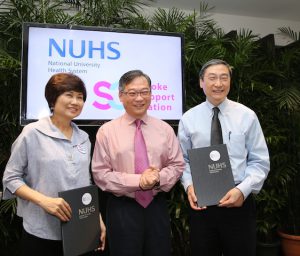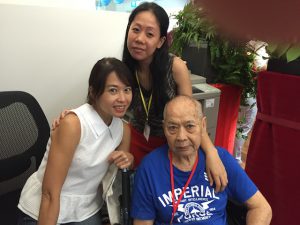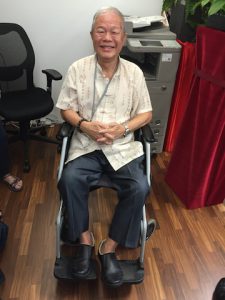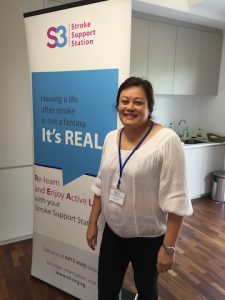On the road to recovery
The first dedicated wellness centre helps stroke survivors after their rehabilitation or discharge so they can lead normal and as full lives as possible.
BY: Eleanor Yap
Stella Mak couldn’t be happier having her 84-year-old father, Mak Weng Choy, go to the Stroke Support Station (S3) Wellness Centre at the Enabling Village. The Centre, which was launched recently, helps stroke survivors, including 21 who are over 50 years old, after they have finished rehabilitation or have been discharged from the hospitals to build their confidence and help them re-integrate into society.
The grandfather of six had a stroke back in December 2014, which affected the right side of his body as well as his speech. Stella shared that when he was discharged from the hospital, he was on tube feeding, couldn’t stand on his own and was bedridden for a while. The 48-year-old added that he used to drink coffee with his friends before his stroke and when he got better, she wanted him to get back to the social life he had before, but found that his friends were too old and don’t come out anymore or they too had a stroke.
When her brother found out about the charity S3 and its Wellness Centre earlier this year, he brought his father to do a day trial to see if he liked the place, and he did. Today, he comes to the Centre three times a week with a helper and takes part in the varied activities including his favourite – ping-pong using his left arm. Stella remarked, “In terms of his temperament and mood, the Centre has helped him. He has also made a lot of friends. There are interactive activities so he can engage with others and this brings a smile to his face. It has also helped his mobility as he couldn’t stand before, but now he can.”
She shared that when her father, who was a shipyard mechanic when younger, was discharged from the hospital after his stroke, he had to go for rehabilitation. “I had to force him to go for the 45-minute workouts twice a week,” Stella said. Weng Choy explained the reason for this: “I am alone there.” However, things are different now – “I don’t have to force him any more as he looks forward to coming to the Wellness Centre,” added Stella.
Growing stroke patients

Witnessed by Minister for Health Gan Kim Yong, Teo Poh Yim of S3 and Professor John EL Wong, chief executive, NUHS, sign a Memorandum of Understanding (MoU) to leverage on the partnership between both organisations to increase awareness on stroke and advance advocacy to enable an inclusive society.
S3 Wellness Centre offers a number of activities under the framework of R.E.A.L (Re-learn & Enjoy Active Living) on Monday, Wednesday and Friday mornings for stroke survivors, including tai-chi for stroke, music and movement, daily living activities such as preparing breakfast and going grocery shopping, show and tell (speech), mindfulness awareness practice (breathing and relaxation), and sharing and counselling. The Centre wants to help these survivors maintain and improve their abilities, get them out of their homes, engage with others, rebuild their confidence and independence, and gain support.
The Centre, which has partnered with the National University Health Systems (NUHS), also has programmes for caregivers such as the Active Living Workshop to provide them with the knowledge and skills to support the stroke survivors, Mindfulness Awareness Practice on relaxation and breathing techniques to reduce stress and build mental resilience, and sharing and group counselling sessions to helps them with coping skills.
Stroke is a significant cause of death and disability in Singapore. According to the National Registry of Diseases Office (NRDO), there are 6,642 cases of stroke in Singapore in 2013, which is an increase of 12 percent from 2010. The number of stroke cases among those between the ages of 50 to 85+ increased from 5,535 to 5,989 between 2011 and 2013. Moreover, according to NUHS, based on an external report, only 27 percent of stroke survivors continue to attend centre-based rehabilitation after one year from their discharge and nearly three-quarters did not continue their rehabilitation. “The need for a community-based post-stroke support programme is apparent to help stroke patients live as normal and as full a life as possible,” explained Teo Poh Yim, founder and chairman of S3.
She added: “Suffering a stroke is a life-changing experience that affects not only the individual but the whole family. The burden of stress is pervasive. Survivors lose confidence, with some unable to return to work. Yet others are self-conscious and withdraw from active participation in society even when they are able. Caregivers are at a loss and they struggle with the challenges of navigating the unknown space of stroke with little knowledge, confusion, unrealistic expectations, leading to frustration and at times, desperation for the whole family.”
Poh Yim also emphasised the misconception that stroke survivors are ready to re-integrate into society soon after their discharge from hospitals. “They face a lot of challenges, fears, self-doubts and adjustment to society. Poor understanding and fears of employers and colleagues may result in them losing their jobs, which can be catastrophic for a stroke survivor and his family. In addition, poor understanding and lack of empathy by society compounds their poor re-integration into society.”
Good news for many
Having the S3 Wellness Centre is good news also to 73-year-old Lau Nam Sang, who had a stroke three years ago. If it wasn’t for the Centre, he shared that he would be at home watching TV and reading the newspaper. He comes to the Centre three times a week, mostly with his wife.
The grandfather of three, who was a kitchen helper at a restaurant for over 30 years, said that after he was discharged from Alexandra Hospital, he had to continue being in the hospital for a half year to do his rehabilitation as he was immobile. The stroke had affected his right side as well as his speech.
After he returned home, he continued to do rehabilitation until the hospital moved, and he felt Jurong Hospital was too far from his home in the Bukit Merah area. He ended up doing some of the rehabilitation at home by himself, and did some slow walking. Earlier this year, he learned about S3 and the Centre from the Redhill CC and decided to come three times a week to join the activities.
Said Nam Sang, “I have met new friends and I feel happier [being here]. I can’t tell now whether I have improved but I believe it will get better if I continue with the regime here.”
The Centre harnesses volunteers to assist in its programmes and S3’s work. Currently, it is looking for volunteers with coaching skills, IT skills, those willing to provide transport and to be counsellors. S3 is also looking for those in the healthcare sector such as physiotherapists, occupational and speech therapists, nurses and other healthcare and administrative professionals.
Sixty-year-old Lena Tan was roped in by friends to volunteer two months ago and is one of seven S3 volunteers who are over the age of 50. She shared that initially she came in to observe but that has turned into coming in twice a week to help with the Centre’s activities. “My perception of stroke was it affected the elderly but I saw young people who had stroke and this was an awakening for me. Volunteering here has been rewarding. … This is like a self-help centre where they help themselves; you get to see the way they motivate each other.”
She shared that once she saw a woman who got excited after she managed to move her toe. “For us able-bodied, we take a lot of things such as physical things for granted, but for them, it is an uphill task. I saw her so delighted and telling us about it that she could now do it since she came here. For her, it was like reaching the Base Camp of Mount Everest!”
Lena shared that she is interested in getting specialist training in speech therapy when S3 starts offering it. “Doing this work is very enriching. You get to know the survivors better and their families. It is not just about giving but also receiving. My perception has changed – stroke can strike anyone, at any age and at any time.”
S3 is supported by a number of donors as well as organisations like St Luke’s Hospital, Ang Mo Kio – Thye Hua Kwan Hospital, Singapore Disability Sports Council, Abilities Beyond Limitations and Expectations (ABLE), and the Radin Mas and Tanjong Pagar Active Ageing Committees. Another supporter is the East Coast Active Ageing Committee, which is planning to recruit volunteers for training at S3 so it wants to start an S3 programme in the East Coast.
** To join S3 Wellness Centre activities, for stroke survivors with the public assistance card, the sessions are free. Those who have the CHAS Blue and CHAS Orange, the fees are S$6 per three-hour session (Pioneer Generation CHAS card is not accepted). For stroke survivors without these concession cards, the fee is S$30 per three-hour session. S3 does also offer a special package of S$300 for 10 sessions, with two additional sessions free.
| SIDEBOX: Free S3 apps S3 has also launched two smartphone apps for the stroke survivor and the caregiver. The stroke survivor app has tips and recommendations about medications; doctors’ recommendations on control of blood pressure, lipids lowering, diabetic control, lifestyle change and psychological well-being; visual pill tracker with timed reminders; and an interactive mood tracker. The caregiver app offers tips with animations about caregiving; caregiving and depression advice through podcasts; Mindfulness Awareness Programme podcast to reduce caregiver stress; and questionnaires to monitor mental wellness of caregivers.The apps can be downloaded on Apple iTunes or Google Play. |
(** WRITER’S NOTE: There is also another organisation called the Singapore National Stroke Association that is open to stroke survivors, caregivers, healthcare professionals and members of the public with an interest in the fight against stroke.)




0 Comments